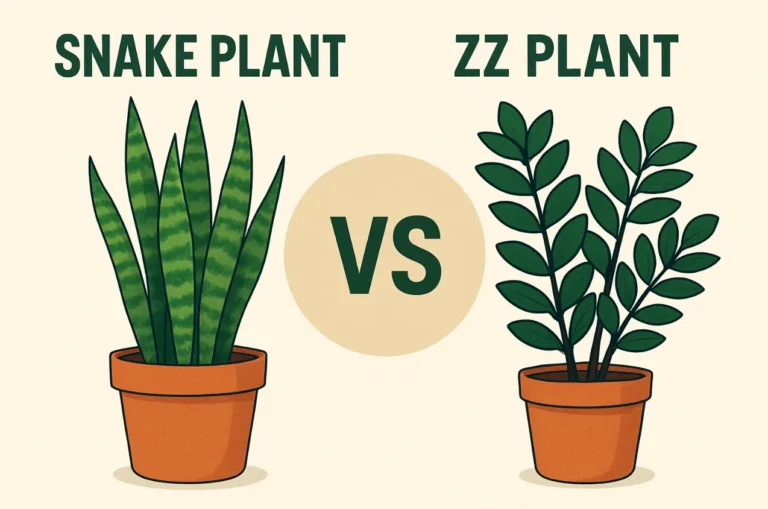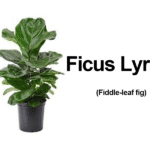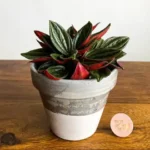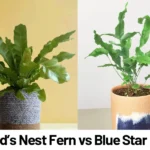Snake Plant vs ZZ Plant: Which One Belongs in Your Home?
The Snake Plant (Sansevieria, now reclassified as Dracaena trifasciata) and the ZZ Plant (Zamioculcas zamiifolia) are two of the most popular houseplants today—and for good reason. They’re both charmingly architectural, incredibly tough, and famously hard to kill. With striking upright foliage, tolerance for low light, and low-maintenance nature, it’s no wonder they’re often found side-by-side in plant shops and Pinterest-ready living rooms.
Due to their similar roles in interior decor and care level, many beginner gardeners confuse the two or wonder which one is better suited to their home. But despite their similar reputations and appearances, these two plants have quite distinct biological roots, growth patterns, and visual personalities. This guide breaks down the Snake Plant vs ZZ Plant to help you choose the perfect green companion for your space.
Quick Comparison Table: Snake Plant vs ZZ Plant
| Feature | Snake Plant | ZZ Plant |
|---|---|---|
| Botanical Name & Family | Dracaena trifasciata (formerly Sansevieria), Asparagaceae | Zamioculcas zamiifolia, Araceae |
| Native Region | West Africa (Nigeria to Congo) | Eastern Africa (Kenya to South Africa) |
| Leaf Shape & Size | Flat, sword-like leaves; 30–150 cm tall | Thick, waxy, oval leaflets on stalks; 40–90 cm tall |
| Growth Habit & Speed | Upright rosette; moderate growth, 10–20 cm/year | Clumping stems from rhizomes; slow growth, 5–10 cm/year |
| Stem Structure | No above-ground stems; leaves arise directly from soil | Thick stalks with compound leaves; rhizomatous base |
| Light Requirements | Low to bright indirect (500–2000 lux) | Low to medium indirect (250–1000 lux) |
| Watering & Humidity | Water every 2–3 weeks; tolerates 30–50% RH | Water every 3–4 weeks; prefers 40–60% RH |
| Pet Safety / Toxicity | Toxic to cats and dogs (saponins) | Toxic to cats and dogs (calcium oxalates) |
| Typical Price & Availability | Widely available; $10–$40 depending on cultivar/size | Moderately available; $15–$50 depending on size |
Key Differences Between Snake Plant and ZZ Plant
Visual Identity: Architectural Spikes vs Glossy Arches
At first glance, both plants have a strong structural presence, making them staples in modern interior design. However, their leaves are radically different upon closer inspection. The Snake Plant features long, flat, sword-like leaves that grow vertically from the base and often display variegation in green, yellow, or silver tones. Some cultivars, like ‘Laurentii’ or ‘Moonshine,’ are prized for their leaf color and vertical form.
In contrast, the ZZ Plant has thick, succulent, dark green leaflets arranged on arching stalks. These shiny, waxy leaves give it a polished, almost plastic appearance—perfect for minimalist or contemporary decor. While the Snake Plant commands attention with sharp lines, the ZZ Plant feels softer and more rhythmic, swaying gently as it grows.
Growth Habit and Space Suitability
The Snake Plant’s leaf-forward growth means it tends to stay upright and contained, making it ideal for corners or narrow spaces where horizontal sprawl isn’t welcome. With some varieties reaching heights over 1 meter, larger Snake Plants can serve as bold visual anchors in a room.
The ZZ Plant grows from underground rhizomes and produces wider, arching stalks, giving it a bushier silhouette. Though it rarely exceeds 90 cm in height, its expanding base can gradually fill out a wider footprint. For tabletops or mid-height stands, the ZZ Plant is a charm—elegant, but not overwhelming.
Care Difficulty and Environmental Preferences
Both plants rank among the easiest houseplants to maintain, especially for beginners. Still, their subtle differences matter. The Snake Plant is slightly more adaptable to different lighting situations, tolerating both full sun and deep shade, whereas the ZZ Plant has a stronger preference for low-light environments and may suffer in bright, direct sun.
When it comes to watering, both prefer to dry out between drinks, but the ZZ Plant is more drought-tolerant due to its rhizomes, which store water over longer periods. Snake Plants may rot with overwatering but appreciate a bit more moisture if light and temperature conditions are higher. Likewise, while neither plant is fussy about humidity, the ZZ Plant prefers moderate levels (40–60% RH), especially in dry indoor air.
Toxicity and Pet Considerations
Unfortunately, both Snake Plants and ZZ Plants are toxic to pets. Snake Plants contain saponins that can cause nausea, vomiting, or diarrhea in cats and dogs if ingested. ZZ Plants contain calcium oxalate crystals, which may irritate the mouth and stomach lining. For households with curious pets, these plants should be kept well out of reach or avoided in favor of truly pet-safe alternatives like Calatheas or Spider Plants.
Which One Should You Choose?
If you’re torn between the Snake Plant and ZZ Plant, the right choice often depends on your space, aesthetic goals, and lifestyle. Here are some tailored recommendations:
- Best for beginners: Both are excellent, but the ZZ Plant edges out for being even more tolerant of missed waterings and lower light levels.
- Small apartments or tight spaces: Snake Plants offer a vertical, compact footprint perfect for tight corners or hallways.
- Statement décor or office settings: Choose the ZZ Plant for its glossy, luxurious texture and fashionable presence.
- Very low light conditions: ZZ Plants thrive better in dim, north-facing rooms or spaces with minimal natural light (250–500 lux).
- Pet-friendly homes: Unfortunately, neither plant is safe if nibbled. Look for non-toxic options like Peperomia, Areca Palm, or Prayer Plant instead.
Conclusion
In the battle of low-maintenance indoor heroes, both the Snake Plant and ZZ Plant shine in their own right. They’re reliable, attractive, and practically indestructible with minimal care. But while they share similar reputations, their looks, growth styles, and subtle needs make them better suited to slightly different roles in your home.
Choose a Snake Plant if you’re looking for a clean, modern visual with height and minimal spread. Opt for a ZZ Plant if you want a glossy showpiece container plant that tolerates occasional neglect. Either way, your living room, office, or bedroom gains a resilient companion that keeps the air cleaner and the vibe greener.
References
- Hessayon, D. G. (2019). The House Plant Expert (Revised Edition). Transworld Publishers.
- Royal Horticultural Society. (n.d.). Zamioculcas zamiifolia: ZZ plant. Retrieved from https://www.rhs.org.uk/plants
- University of Florida, IFAS Extension. (2022). Sansevieria trifasciata (now Dracaena trifasciata) – UF/IFAS Gardening Solutions. Retrieved from https://gardeningsolutions.ifas.ufl.edu








